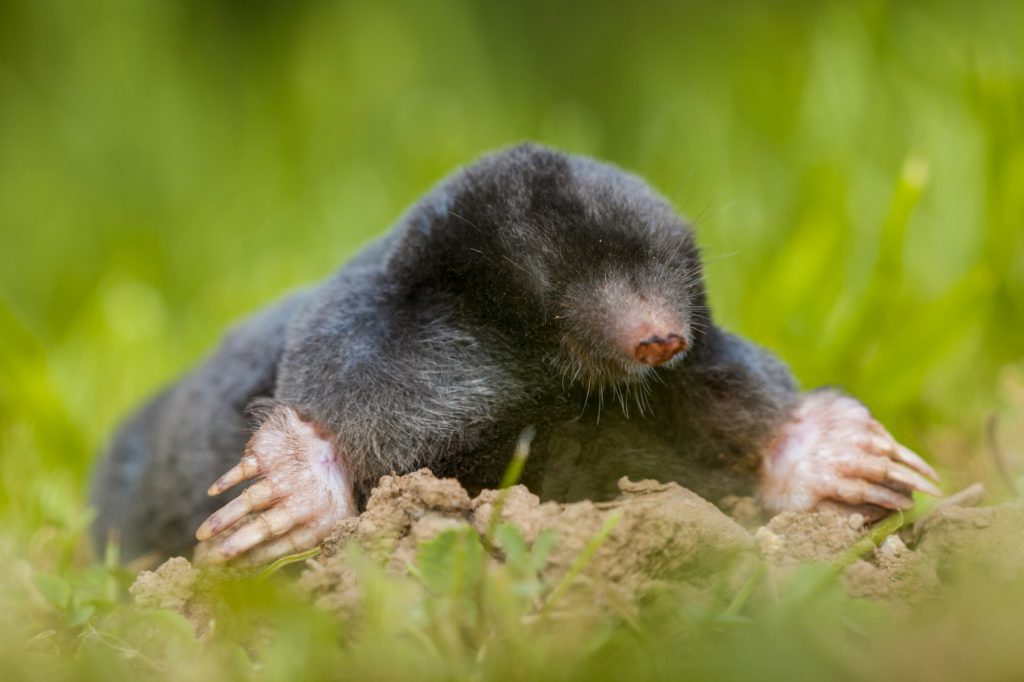How to Get Rid of Moles in Your Yard
Moles are small, burrowing mammals that can become a significant nuisance in yards due to the extensive tunnel systems they create. Read more about moles in your lawn from the experts at Michigan State University. These tunnels can damage lawns, uproot plants, and disturb the soil, making mole infestations a common problem for homeowners. However, before taking action, it’s essential to correctly identify moles, as they are often mistaken for other pests like voles or gophers. Moles primarily feed on insects and earthworms, so their presence can indicate healthy soil, though their tunneling can be disruptive.
There are several methods to control mole populations. Humane and effective approaches include using mole repellents, which drive them away without harm. These repellents may contain natural ingredients like castor oil or be in a sonic form, emitting vibrations that deter moles. Another humane option is to trap and relocate moles to a more suitable habitat. For those seeking long-term solutions, managing the mole’s food source (such as grubs) can make the yard less appealing. While some may resort to lethal traps, it’s important to consider non-lethal methods to maintain ecological balance an reduce unnecessary harm to wildlife. Proper identification and thoughtful removal strategies can help restore the yard without negatively impacting the environment.
Easily hire the best lawn & landscape pros working in your neighborhood.
What Are Moles?
Moles are small, burrowing mammals known for their extensive tunnel systems and distinctive star-shaped noes (in some species) that aid in their remarkable sense of touch. They belong to the family Talpidae and are adapted for a subterranean lifestyle, with strong, paddle-like forelimbs and sharp claws used for digging. Moles have tiny, almost vestigial eyes, as their underground existence minimizes the need for vision. Their sleek, velvety fur allows them to move effortlessly through the soil without getting tangled.
Moles are insectivores, primarily feeding on earthworms, grubs, and various insects found within the soil. Their high metabolism requires them to consume large quantities of food, which is why they are constantly foraging. They dig two types of tunnels: surface tunnels, which create the raised ridges often seen in yards, and deeper tunnels, where they live and store food. Moles are solitary and territorial creatures, typically occupying large areas by themselves.
Yards become an attractive habitat for moles if they offer ideal conditions, such as moist, loose, and nutrient-rich soil that supports and abundant supply of earthworms and insects. Lawns that are regularly watered and fertilized, as well as gardens with thick vegetation or mulch, provide perfect environments for moles to dig and hunt. Additionally, areas with minimal foot traffic or pet activity are seen as safe zones, free from disturbances. Moles choose yards because these settings offer a stable food source, easy digging, and protection.

What Attracts Moles to Your Yard?
Moles are attracted to yards with abundant food sources, particularly insects like grubs, beetles, and their favorite, earthworms. Healthy, well-irrigated soil rich in organic matter provides the perfect environment for these creatures to thrive. Damp, loose soil makes it easier for moles to dig tunnels, and well-watered lawns or gardens are particularly appealing. Moles are also drawn to areas with thick grass, mulch, or other landscaping elements that offer good ground cover, which protects them from predators as they dig and forage.
Additionally, yards with minimal human or pet activity create a more peaceful environment for moles. Certain landscaping features, such as dense vegetation or areas with excess thatch, can further attract them by providing ample hiding spots. Moles seek out these favorable conditions to establish their tunnel systems, making some yards more vulnerable to mole activity than others. Maintaining balanced conditions can help deter their presence.
How to Identify Mole Activity in Your Yard
Distinguishing mole activity from other underground pests, such as voles and gophers, requires careful observation of the signs they leave behind. Moles are known for creating volcano-shaped molehills, which result from their excavation as they push excess soil to the surface. These molehills are typically small and rounded, with finely sifted soil. In contrast, gopher mounds are more irregular in shape, often fan- or crescent-shaped, with a visible plug of soil sealing their tunnel entrance. Voles do not create mounds or raised soil but rather leave small, shallow burrows at ground level, often near the roots of plants.
Mole tunnels are another distinguishing feature. Moles create two types of tunnels: surface tunnels, which appear as raised ridges across the lawn, and deeper tunnels, where they live and forage. Surface tunnels are often winding and can be felt underfoot, indicating the mole’s active search for food. Sopher tunnels, on the other hand, are generally deeper and less visible on the surface, but their entrances are larger and more noticeable. Voles create narrow, well-worn runways at ground level, often near garden beds or under dense vegetation, with no raised soil.
Soil upheaval caused by moles is generally loose and smooth, a result of their digging for food. Gophers displace larger clumps of soil, while voles rarely disturb the soil in the same way. By paying attention to these specific signs, it becomes easier to accurately identify mole activity and differentiate it from other underground pests.

Difference Between Moles, Voles, and Pock Gophers
Moles, voles, and pocket gophers are often mistaken for one another, but they have distinct characteristics and behaviors. Additional information can be found on Oregon State Universities article titled “Moles, voles, and gophers dig the garden.” Moles are small, insectivorous mammals with paddle-like front paws adapted for digging. They create visible raised ridges and round molehills while tunneling in search of earthworms and insects. Unlike moles, voles are rodents, resembling small mice, and are herbivores. Voles create surface-level runways and burrow near plants, damaging roots and vegetation as they feed. They don’t produce large mounds or visible ridges but instead create small, shallow holes near the surface.
Pocket gophers are also rodents but larger than voles and moles, with strong teeth for gnawing through roots and bulbs. Gophers create fan-shaped or crescent-shaped mounds, often plugging their tunnel entrances with dirt. While moles hunt for insects underground, gophers primarily feed on plant material, making them a significant threat to crops and gardens. Each species leave unique signs, making identification important for effective control.

Easily hire the best lawn & landscape pros working in your neighborhood.
Effective Methods to Get Rid of Moles
Mole removal strategies range from human methods to lethal solutions, allowing homeowners to choose the approach that best suits their needs and ethical preferences. Human methods often involve repellents and deterrents that aim to drive moles away without causing harm. For instance, mole repellents containing castor oil are popular; they work by soaking into the soil, making it unappealing for moles to tunnel through. When applied regularly, these repellents can gradually force moles to relocate. Sonic or vibrating deterrents are another humane option. These devices emit low-frequency vibrations into the ground, creating an uncomfortable environment for moles, which rely on sensitive touch for navigation. Both options are effect for educing mole activity without harming the animals.
For those seeking more direct and long-term control, traps are a common solution. Humane traps, such as live-catch traps, can be placed within active mole tunnels. Once captured, moles can be relocated to a more suitable environment, away from residential areas. Relocating moles requires caution to ensure they are moved to a location where they can thrive without causing issues.
Lethal options, while effective, are less humane. Scissor traps and harpoon traps are widely used to kill moles by catching them in their tunnels. These traps are placed in active runs and trigger when a mole passes through, instantly killing the animal. Although efficient, lethal traps require careful placement to ensure proper alignment with the mole’s tunnel system. Some people resort to poisons, but these are not recommended due to the risk of harming non-target animals, including pets, or contaminating the soil and groundwater.
A less direct yet effective strategy involves reducing the mole’s food supply. By treating the lawn for grubs or other insects that moles feed on, homeowners can make their yard less appealing, encouraging moles to move elsewhere. Ultimately, the most effective mole removal strategy depends on personal preference, environmental factors, and the level of infestation. Human options are preferable for those looking to minimize harm, while lethal methods provide faster results for severe infestations.
Humane Solutions
Non-lethal, or humane methods for mole control focus on driving moles away without causing harm. Natural repellents, such as castor oil-based products, are commonly used to deter moles. When applied to the soil, these repellents make it unpleasant for moles to tunnel, forcing them to move elsewhere. Other natural options include planting mole-repelling plants like marigolds or daffodils, which produce strong scents that moles avoid.
Ultrasonic devices are another human option. These battery-operated or solar-powered devices emit low-frequency vibrations that disturb that moles’ sensitive sense of touch, making the environment uncomfortable and prompting them to leave.
Exclusion techniques aim to prevent moles from accessing certain areas. This can include creating physical barriers, such as installing wire mesh or metal screens buried around gardens and lawns. These barriers block moles from tunneling into protected areas, keeping them away from high-priority spaces without harm. All these methods are eco-friendly and non-lethal.

Lethal Solutions
Lethal methods for mole removal typically involve traps and poison bait. Scissor traps and harpoon traps are commonly used, designed to snap shut and kill moles instantly when they pass through an active tunnel. These traps are effective but require precise placement along well-used mole runways to ensure success. Another option is poison bait, usually designed to mimic earthworms or grubs, which moles ingest while foraging. The poison acts quickly to eliminate the mole population.
While these methods can provide fast results, they come with risks. Poison bait can be hazardous to non-target animals like pets and wildlife, as well as potentially contaminating the soil. Lethal methods should be considered carefully and only used if non-lethal approaches have failed.
Before using any lethal methods, it’s crucial to check local laws and regulations, as some areas restrict the use of certain traps or poisons due to environmental concerns or animal protection lawns.
Home Remedies to Repel Moles
Several DIY solutions and home remedies can help repel moles naturally without harming then. These methods often use household ingredients, making them cost effective and eco-friendly.
Castor oil is a popular mole repellent. To create a solution, mix 3 tablespoons of castor oil with one tablespoon of liquid dish soap and dilute this in a gallon of water. Spray the mixture over mole-infested areas. The oily texture makes the soil less appealing for moles to dig through, driving them away. Reapply after rain for continued effectiveness.
Garlic is another strong deterrent. Crush several garlic cloves and place them directly into active mole tunnels. Moles dislike the strong odor, which encourages them to relocate. You can also add minced garlic to water and pour it over the lawn.
Cayenne pepper can also repel moles. Mix a few tablespoons of cayenne with water and spray it around molehills or tunnels. The spicy pepper irritates the moles’ sensitive noses, deterring them from returning.
Other natural repellents include planting mole-repelling plants like marigolds, daffodils, or alliums. These plants release strong scents that moles avoid. Simply plant them around gardens or mole-prone areas for long-term control.
Lastly, using household ammonia or vinegar can help. Soak rags in ammonia or vinegar and place them in mole tunnels. The pungent smell repels moles and prevents further digging.
These natural remedies are safe, effective, and easy to implement, helping you keep moles at bay without chemicals.

Preventing Moles from Entering Your Yard
Homeowners can take several proactive measures to prevent moles from invading their yards by altering the conditions that make the environment attractive to them. One of the most effective strategies is maintaining compact soil. Moles prefer loose, moist soil because it’s easier to tunnel through. Regularly aerating and compacting your soil, especially in mole-prone areas, can make it more difficult for moles to dig. Avoid overwatering lawns or gardens, as moist soil not only invites moles but also encourages the growth of the insects they feed on.
Another key preventative measure is eliminating their food sources. Moles primarily eat insects, especially grubs and earthworms. Treating your lawn with grub control products, or using natural methods like introducing beneficial nematodes, can reduce the mole’s food supply. By decreasing the number of insects, particularly in moist, shady areas where they thrive, you make your yard less appealing to moles. Keep in mind, however, that earthworms are also beneficial to soil health, so it’s important to balance pest control with maintaining soil ecology.
Creating physical barriers is another excellent way to keep moles at bay. Installing underground barriers, such as wire mesh or metal screens, around gardens or lawns can prevent moles from burrowing into protected areas. These barriers should be buried at least 24 to 36 inches deep to prevent moles from digging underneath them. Some homeowners also use edging materials or hardware cloth around flower beds or at the base of trees to block entry points.
Regular yard maintenance, such as removing excess thatch, keeping lawns well-trimmed, and reducing clutter, can further deter moles. These measures disrupt the conditions that moles need to thrive, making your yard an unattractive place for them to establish their tunnels and feeding grounds.
Easily hire the best lawn & landscape pros working in your neighborhood.
Planting and Using Barriers
Certain plants and underground fences can effectively deter moles by making the environment less appealing to them. Plants such as marigolds, daffodils, alliums, and castor beans release strong scents that moles find unpleasant, discouraging them from tunneling nearby. These plants can be strategically places around gardens, flower beds, or along the edges of lawns to create a natural barrier. Castor bean plants, while effective, are toxic, so they should be used cautiously in areas without pets or children.
Underground fences provide a physical barrier to keep moles out. These fences can be made of metal mesh or hardware cloth and should be installed around key areas like gardens or lawns. To be effective, the fence should be buried at least 24 to 36 inches deep with a portion of it extending 6 to 12 inches above ground to prevent moles from burrowing beneath or climbing over the barrier.

Eliminating Food Sources
Reducing mole food sources, such as grubs and insects, is an effective pest control method to make your yard less appealing to moles. Moles primarily feed on grubs, earthworms, and other soil-dwelling insects. Applying grub control treatments to your lawn, either through chemical pesticides or natural solutions like beneficial nematodes or milky spore, can significantly reduce the grub population. Beneficial nematodes are microscopic organisms that parasitize grubs, helping control their numbers without harming plants or other wildlife.
Insecticides targeted at beetle larvae, like chafer beetles and Japanese beetles, can also minimize mole food sources. Another natural method is introducing predatory beetles, which consume grubs and other soil pests, reducing mole prey. Additionally, proper lawn care practices such as avoiding overwatering, aerating the soil, and removing thatch can make the lawn less attractive to insects and, in turn, to moles looking for food.
Common Mistakes to Avoid When Trying to Get Rid of Moles
Certain methods used to get rid of moles are not only ineffective but can also be harmful to the environment, pets, or humans. One common yet ineffective tactic is using mothballs in mold tunnels. Mothballs contain chemicals like naphthalene, which are toxic and can contaminate the soil and groundwater, posing health risks to pets and humans without effectively driving moles away. Another dangerous method is placing broken glass or sharp objects in mole tunnels. While intended to injure the moles, this approach is cruel and hazardous to both the mole and anyone working in the yard.
Flooding mole tunnels is another commonly attempted method. However, moles are excellent diggers and swimmers, so this usually only causes temporary disruption. It wastes water and can damage your lawn without solving the problem.
Instead of these harmful tactics, safe and more effective alternatives include using castor oil-based repellents, which make the soil unpleasant for moles to dig through without harming them. Installing underground barriers, such as mesh or wire, around gardens or specific areas can physically block moles from tunneling. Additionally, employing natural grub control methods like beneficial nematodes will help reduce the mole’s food source, making your yard less attractive to them. Human traps and sonic devices also offer non-lethal, environmentally friendly alternatives. These options are far more effective and safer for your yard, family, and local wildlife.
Recommended Products for Mole Control
Several effective products on the market can help homeowners manage mole activity, including traps, repellents, and barriers. One widely used product is scissor or harpoon mole traps, such as Victor Out O’Sight Mole Trap. These traps are lethal and designed to instantly kill moles as they pass through active tunnels. Pros: High effectiveness for severe infestations. Cons: Requires precise placement and can be inhumane for some.
For a more humane approach, live-catch traps, like the Havahart Mole Trap, allow for relocation. Pros: Safe and humane, capturing moles without harm. Cons: Requires regular checking and relocation, which may not always be feasible.
Castor oil-based repellents, such as Bonide MoleMax, work by making the soil unappealing to moles. These repellents are applied to lawns and gardens, driving moles away naturally. Pros: Non-lethal, environmentally safe, easy to apply. Cons: Needs reapplication after main and may take time to see results.
For those wanting a physical barrier, mole barriers like Yard Gard Mole Mesh provide a long-term solution. This fine wire mesh is buried underground, preventing moles from entering certain areas. Pros: Effective long-term, non-toxic. Cons: Labor-intensive to install and requires significant yard disruption.
Ultrasonic devices, such as Solar Mole Repellers, emit vibrations to drive moles away. Pro: Easy installation, solar-powered. Cons: Results can vary depending on soil conditions, and some users report moles returning once devices are removed.
Each product has its pros and cons, so selecting the right one depends on the size of the infestation and homeowner preference.

When to Call a Professional for Mole Removal
DIY mole control methods are often effective for minor infestations, but there are times when hiring a professional pest control service becomes necessary. One key factor to consider is the severity of the infestation. If mole activity is widespread, with numerous tunnels and molehills across your yard, DIY methods may not provide sufficient or lasting results. Large infestations often require specialized techniques and expertise that professionals can offer, ensuring more comprehensive and long-term control.
Another consideration is the extent of damage to your lawn or garden. Moles can cause significant disruption to landscaping, leaving behind unsightly mounds, uprooted plants, and damaged grass. If the damage is extensive or impacting your garden’s health, professional intervention can help restore your yard and prevent further destruction. Pest control experts can identify the most effective treatments, whether through targeted trapping or habitat modification, minimizing further lawn damage.
Local regulations may also influence the decision to hire professionals. Some areas have restrictions on the use of certain traps, poisons, or removal methods. Licensed pest control companies are familiar with these regulations and can ensure compliance while effectively managing mole populations. Additionally, professionals have access to more advanced tools and products that may not be available to homeowners.
In situations where DIY efforts fail or the mole problem worsens, a professional pest control service can provide tailored, effective solutions, saving time, money, and stress while protecting your property and ensuring safe, legal mole removal.
Frequently Asked Questions About Moles
Homeowners often have several common questions about moles an dhow to deal with them effectively. One frequently asked question is: What is the fasted way to get rid of moles naturally? The quickest natural method involves using castor oil-based repellents. These products make the soil unpleasant for moles, encouraging them to leave. A solution of castor oil and water can be sprayed over affected areas to repel them. Additionally, introducing plants like marigold, daffodils, or garlic that emit strong scents can deter moles without harming them. However, natural methods take time, often requiring several applications and patience.
Another question is: How deep do mole tunnels go? Moles create two types of tunnels: surface-level feeding tunnels, which are shallow and typically 2-8 inches deep, and deeper burrows, which go as far at 12 to 18 inches underground. The deeper tunnels are where moles live and breed, while the shallow tunnels are used to hunt for food.
Many homeowner wonder: Will moles leave on their own? In some cases, moles may leave once they have exhausted their food supply or as seasons change. However, this is rare, and they typically remain in areas with an abundance of food, such as grubs and insects. If conditions remain favorable, moles are likely to stay and continue digging tunnels. Proactive measures like reducing food sources or using repellents can help encourage them to leave faster.
While most can occasionally leave on their own, it’s best to take action to prevent prolonged damage to lawns and gardens. Natural methods can be effective but require persistence and ongoing effort to see lasting results.
Conclusion
In conclusion, effective mole control involves a mix of preventative measures and humane solutions. Key strategies include maintaining compact soil, reducing mole food sources like grubs and insects, and creating physical barriers such as underground mesh. Natural repellents, like castor oil or garlic, and sonic deterrents provide safe, non-lethal options for keeping moles at bay. While traps and poisons are available, they should be used cautiously and in accordance with local regulations.
Preventing moles from establishing in the first place is ideal, and regular yard maintenance, such as aeration, treating for pests, and planting mole-repelling plants, can help. Homeowners should monitor their lawns frequently for signs of mole activity, such as molehills and tunnels, and take prompt action when needed to avoid extensive damage. By focusing on humane and environmentally friendly solutions, homeowners can effectively manage moles while maintaining a healthy and thriving yard.




